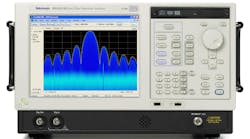Survey Provides In-Depth Overview Of Spectrum Analyzers
This file type includes high resolution graphics and schematics when applicable.
Modern spectrum analyzers have capabilities far beyond the frequency-selective and peak-responding voltmeters that are calibrated to display RMS values of their sine waves of origin. A swept-tuned spectrum analyzer uses a superheterodyne receiver to down-convert the spectrum of the input signal to the center frequency of a band-pass filter using a mixer and voltage-controlled oscillator (VCO). The 120-page application note by Agilent, “Application Note 150: Spectrum Analysis Basics,” offers a rigorous walk-through of the capabilities and understanding behind the operation of swept-tuned superheterodyne spectrum analyzers. Analyzing electrical signal spectra can give the designer valuable information on the spectral components of a signal not easily detectable in time-domain waveforms.
A spectrum is a properly combined collection of sine waves that produce a desired time-domain signal. The value of monitoring a spectrum lies in the ability to measure the energy throughout a frequency domain. For example, this knowledge is necessary in determining if signal energy is spilling into other frequency bands for cellular communications and to determine what interference with other electronics can be expected during device operation.
Spectrum analyzers are made from hundreds of high-precision and high-performing parts, which are carefully matched and tuned to maintain optimum performance. These complex parts all play a role in measuring the various aspects of the signal response of a device under test (DUT). To meet modern demands, spectrum analyzers have included many of the capabilities traditionally held by vector signal analysis and Fourier signal analyzers—for example, the all-digital intermediate-frequency (IF) operation, which Agilent claims to have implemented with many operational benefits. Some of these benefits include a combination of Fast Fourier Transform (FFT) analysis for narrow spans and swept analysis for wide spans for a more optimal approach. Other modern spectrum analyzers also sport application-specific measurement functions such as vector signal analysis and adjacent channel power (ACP).
Overall, the note strives to provide an in-depth summary of the building blocks of spectrum-analyzer operation, covering amplitude/frequency accuracy, sensitivity/noise, dynamic range, and frequency range. Included is a special dedication to the note’s original author Blake Peterson, who received the Microwaves & RF “Living Legend” award in June 2013.
Agilent Technologies, 5301 Stevens Creek Blvd., Santa Clara, CA 95051; (408) 345-8886.
This file type includes high resolution graphics and schematics when applicable.

